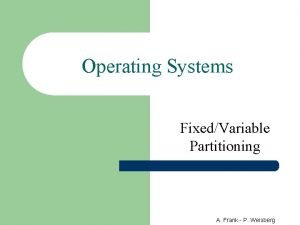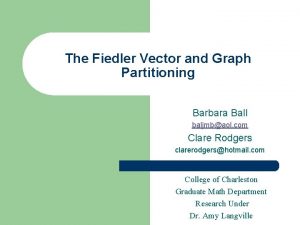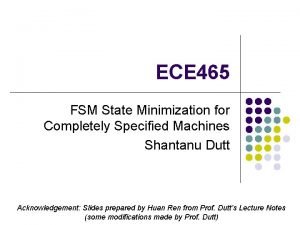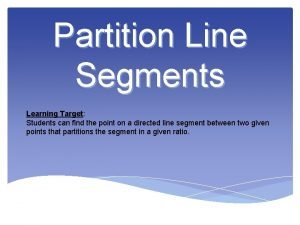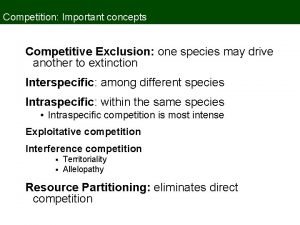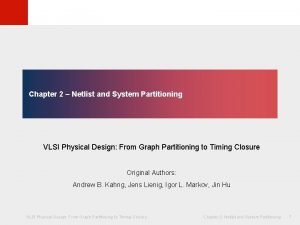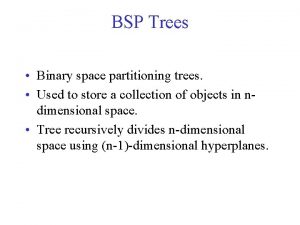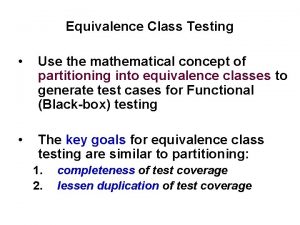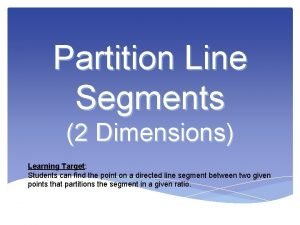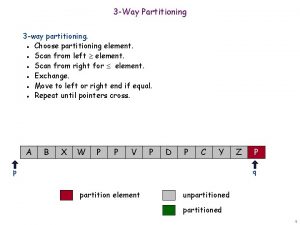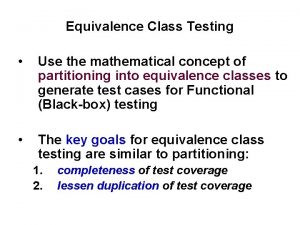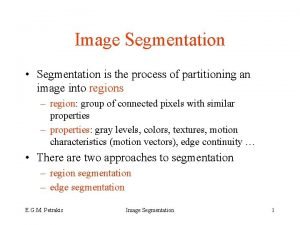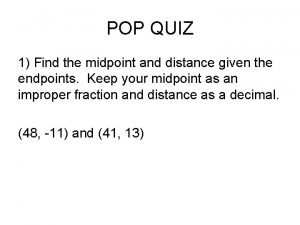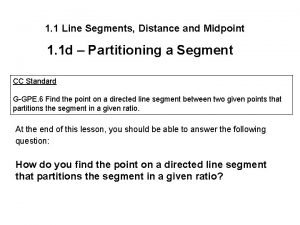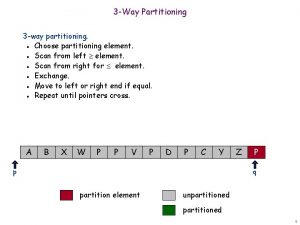Graph Partitioning Dr Frank Mc Cown Intro to


















































- Slides: 50

Graph Partitioning Dr. Frank Mc. Cown Intro to Web Science Harding University This work is licensed under a Creative Commons Attribution-Non. Commercial. Share. Alike 3. 0 Unported License

Slides use figures from Ch 3. 6 of Networks, Crowds and Markets by Easley & Kleinberg (2010) http: //www. cs. cornell. edu/home/kleinber/networks-book/

Co-authorship network How can the tightly clustered groups be identified? Newmam & Girvan, 2004

Karate Club splits after a dispute. Can new clubs be identified based on network structure? Zachary, 1977

Graph Partitioning • Methods to break a network into sets of connected components called regions • Many general approaches – Divisive methods: Repeatedly identify and remove edges connecting densely connected regions – Agglomerative methods: Repeatedly identify and merge nodes that likely belong in the same region

Divisive Methods 1 2 3 7 4 6 5 10 9 11 12 13 8 14

Agglomerative Methods 1 2 3 7 4 6 5 10 9 11 12 13 8 14

Girvan-Newman Algorithm • Proposed by Girvan and Newman in 2002: Community structure in social and biological networks • Divisive method • Identifies edges to remove using edge betweenness • Edge betweenness: Total amount of “flow” an edge carries between all pairs of nodes where a single unit of flow between two nodes divides itself evenly among all shortest paths between the nodes (1/k units flow along each of k shortest paths)

Edge Betweenness Example 1 2 3 Calculate total flow over edge 7 -8 7 4 6 5 10 9 11 12 13 8 14

10 1 2 3 One unit flows over 7 -8 to get from 1 to 8 7 4 6 5 9 11 12 13 8 14

10 1 2 3 One unit flows over 7 -8 to get from 1 to 9 7 4 6 5 9 11 12 13 8 14

10 1 2 3 One unit flows over 7 -8 to get from 1 to 10 7 4 6 5 9 11 12 13 8 14

10 1 2 3 7 4 6 5 7 total units flow over 7 -8 to get from 1 to nodes 8 -14 9 11 12 13 8 14

10 1 2 3 7 4 6 5 7 total units flow over 7 -8 to get from 2 to nodes 8 -14 9 11 12 13 8 14

10 1 2 3 7 4 6 5 7 total units flow over 7 -8 to get from 3 to nodes 8 -14 9 11 12 13 8 14

7 x 7 = 49 total units flow over 7 -8 from nodes 1 -7 to 8 -14 1 2 3 7 4 6 5 10 9 11 12 13 8 14

Edge betweenness = 49 1 2 3 7 4 6 5 10 9 11 12 13 8 14

10 1 2 3 Calculate betweenness for edge 3 -7 7 4 6 5 9 11 12 13 8 14

1 2 3 3 units flow from 1 -3 to each 4 -14 node, so total = 3 x 11 = 33 7 4 6 5 10 9 11 12 13 8 14

Betweenness = 33 for each symmetric edge 1 2 10 3 7 4 6 5 11 12 13 33 33 33 9 8 33 14

1 2 3 7 4 6 5 10 Calculate betweenness for edge 1 -3 9 11 12 13 8 14

1 2 3 7 4 6 5 10 Carries all flow to node 1 except from node 2, so betweenness = 12 9 11 12 13 8 14

1 2 12 12 betweenness = 12 for each symmetric edge 9 3 7 4 12 5 12 10 12 11 8 6 12 12 14 13

1 2 3 7 4 6 5 10 Calculate betweenness for edge 1 -2 9 11 12 13 8 14

1 2 10 Only carries flow from 1 to 2, so betweenness = 1 3 7 4 6 5 9 11 12 13 8 14

1 1 2 3 7 4 1 10 betweenness = 1 for each symmetric edge 6 1 9 11 12 13 8 1 5 14

1 2 1 12 Edge with highest betweenness 12 9 3 33 33 7 33 4 1 12 5 12 49 10 12 1 11 8 33 6 12 12 13 1 14

Node Betweenness • Betweenness also defined for nodes • Node betweenness: Total amount of “flow” a node carries when a unit of flow between each pair of nodes is divided up evenly over shortest paths • Nodes and edges of high betweenness perform critical roles in the network structure

Girvan-Newman Algorithm 1. Calculate betweenness of all edges 2. Remove the edge(s) with highest betweenness 3. Repeat steps 1 and 2 until graph is partitioned into as many regions as desired

Girvan-Newman Algorithm 1. Calculate betweenness of all edges 2. Remove the edge(s) with highest betweenness 3. Repeat steps 1 and 2 until graph is partitioned into as many regions as desired How much computation does this require? Newman (2001) and Brandes (2001) independently developed similar algorithms that reduce the complexity from O(mn 2) to O(mn) where m = # of edges, n = # of nodes

Computing Edge Betweenness Efficiently For each node N in the graph 1. Perform breadth-first search of graph starting at node N 2. Determine the number of shortest paths from N to every other node 3. Based on these numbers, determine the amount of flow from N to all other nodes that use each edge Divide sum of flow of all edges by 2 Method developed by Brandes (2001) and Newman (2001)

F Example Graph B C I A D G E H J K

Computing Edge Betweenness Efficiently For each node N in the graph 1. Perform breadth-first search of graph starting at node N 2. Determine the number of shortest paths from N to every other node 3. Based on these numbers, determine the amount of flow from N to all other nodes that use each edge Divide sum of flow of all edges by 2

Breadth-first search from node A B A C F E D G H J I K

Computing Edge Betweenness Efficiently For each node N in the graph 1. Perform breadth-first search of graph starting at node N 2. Determine the number of shortest paths from N to every other node 3. Based on these numbers, determine the amount of flow from N to all other nodes that use each edge Divide sum of flow of all edges by 2

A 1 B C D 1 E 1 add F add G 1 2 H add I add J 3 add K 6 3 2 1

Computing Edge Betweenness Efficiently For each node N in the graph 1. Perform breadth-first search of graph starting at node N 2. Determine the number of shortest paths from N to every other node 3. Based on these numbers, determine the amount of flow from N to all other nodes that use each edge Divide sum of flow of all edges by 2

A 1 B C F D 1 G 1 2 I Work from bottom-up starting with K H J 3 K 6 E 1 3 2 1

A 1 B C F D 1 G 1 2 I K gets 1 unit; equal, so ½ evenly divide 1 unit K H J 3 ½ 6 E 1 3 2 1

A 1 B C F I keeps 1 unit & passes along ½ unit; gets 2 times as much from F D 1 G 1 2 1 H ½ I J 3 ½ ½ K 6 E 1 3 2 1

A 1 B C F D 1 G 1 2 1 ½ I H ½ 1 J 3 ½ ½ K 6 E 1 1 2 J keeps 1 unit & 3 passes along ½ unit; gets 2 times as much from H

A 1 B C 1 D 1 E 1 1 F F keeps 1 unit & passes along 1 unit; equal, so divide evenly G 1 2 1 ½ I H ½ 1 J 3 ½ ½ K 6 3 2 1

A 1 B C 1 D 1 1 F G keeps 1 unit & passes along 1 unit E 1 2 G 1 2 1 ½ I H ½ 1 J 3 ½ ½ K 6 3 2 1

A 1 B C 1 D 1 1 F 2 1 ½ I H ½ 1 J 3 ½ ½ K 6 1 1 1 G 1 2 E 1 2 H keeps 1 unit & 3 passes along 1 unit; equal, so divide evenly

B keeps 1 & passes 1 1 A 2 B C 1 D 1 1 F 2 1 ½ I H ½ 1 J 3 ½ ½ K 6 1 1 G 1 2 E 1 3 2 1

C keeps 1 & passes 1 1 A 2 2 B C 1 D 1 1 F 2 1 ½ I H ½ 1 J 3 ½ ½ K 6 1 1 G 1 2 E 1 3 2 1

D keeps 1 & passes along 3 A 2 1 B C 1 4 2 D 1 1 F 2 1 ½ I H ½ 1 J 3 ½ ½ K 6 1 1 G 1 2 E 1 3 2 1

A 2 1 B C 1 D 1 1 F 2 4 2 2 1 ½ I H 1 J ½ ½ K 6 1 1 ½ 3 E 1 G 1 2 E keeps 1 & passes along 1 3 2 1

No flow yet… A 2 1 B C 1 D 1 1 F 2 4 2 2 1 ½ I H ½ 1 J 3 ½ ½ K 6 1 1 G 1 2 E 1 3 2 1

Computing Edge Betweenness Efficiently For each node N in the graph Repeat for B, C, etc. 1. Perform breadth-first search of graph starting at node N 2. Determine the number of shortest paths from N to every other node 3. Based on these numbers, determine the amount of flow from N to all other nodes that use each edge Divide sum of flow of all edges by 2 Since sum includes flow from A B and B A, etc.
 Cown definition
Cown definition Fixed partitioning and dynamic partitioning
Fixed partitioning and dynamic partitioning Fiedler vector graph partitioning
Fiedler vector graph partitioning Frank william abagnale jr. frank abagnale, sr.
Frank william abagnale jr. frank abagnale, sr. Line graph graph theory
Line graph graph theory Wait-for graph
Wait-for graph Equivalence partitioning example
Equivalence partitioning example Contoh equivalence partitioning
Contoh equivalence partitioning State minimization partitioning method
State minimization partitioning method 3-way partitioning
3-way partitioning Oracle interval partitioning by month example
Oracle interval partitioning by month example Partitioning a line segment
Partitioning a line segment Hw sw partitioning
Hw sw partitioning Exploitative competition
Exploitative competition Fm algorithm partitioning example
Fm algorithm partitioning example Sql server vertical partitioning
Sql server vertical partitioning Oracle interval partitioning by month example
Oracle interval partitioning by month example Partitioning of primordial ventricle
Partitioning of primordial ventricle Which are the characteristics of equivalence partitioning
Which are the characteristics of equivalence partitioning Bsp tree
Bsp tree Input space partitioning
Input space partitioning Equivalence partitioning black box testing
Equivalence partitioning black box testing Equivalence class testing example
Equivalence class testing example Equivalence partitioning
Equivalence partitioning Design partitioning in vlsi
Design partitioning in vlsi Resource partitioning
Resource partitioning Partitioning a line segment calculator
Partitioning a line segment calculator Europe partitioning in southwest asia answer key
Europe partitioning in southwest asia answer key Partition point formula
Partition point formula Realized niche
Realized niche European partitioning
European partitioning Greedy algorithm scheduling
Greedy algorithm scheduling Resource partitioning
Resource partitioning Contoh equivalence partitioning
Contoh equivalence partitioning 3-way partitioning
3-way partitioning Channel partitioning mac protocols
Channel partitioning mac protocols Channel partitioning protocols
Channel partitioning protocols Weak equivalence class testing
Weak equivalence class testing What is european partitioning?
What is european partitioning? Resource partitioning tends to lead to a high degree of
Resource partitioning tends to lead to a high degree of Channel partitioning vs random access
Channel partitioning vs random access Segmentation is the process of: *
Segmentation is the process of: * Partitioning across africa cloze notes
Partitioning across africa cloze notes European partitioning across africa
European partitioning across africa Unit vector example
Unit vector example Colonization of africa
Colonization of africa Partitioning
Partitioning European partitioning across africa
European partitioning across africa Error yang dapat diketahui dari pengujian black box adalah
Error yang dapat diketahui dari pengujian black box adalah Midpoint formula quiz
Midpoint formula quiz Partitioning a line segment formula
Partitioning a line segment formula

